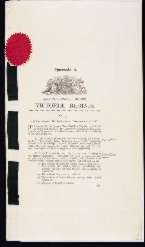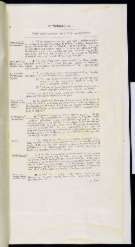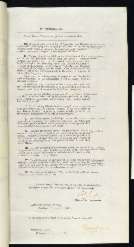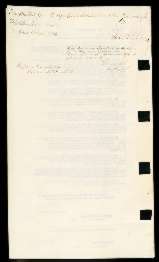

Pacific Island Labourers Act Amendment Act 1884 (Qld)
Significance
This Act was the model for the Commonwealth legislation from 1901 to 1904, including the Pacific Islanders Labourers Act 1901 and the Immigration Restriction Act 1901, which provided the legislative basis for the White Australia policy. Although this was not the first Queensland Act introduced to regulate the Pacific Islanders labour trade, it had the most enduring significance as it created class-like groups amongst the Islanders: first-indenture labourers limited to tropical agriculture; time-expired labourers, some likewise limited to tropical agriculture and others who could work anywhere in the Colony; and lastly 'ticket-holders', the pre-September 1879 immigrants who were bound only by the normal laws of Queensland.
History
From 1863, when Pacific Islander labourers first entered Queensland, there were arguments over the nature of their recruitment – whether they were kidnapped slaves or indentured labourers – and over their working and living conditions in Queensland. In the 1860s and 1870s they were employed across a wide geographic area, in pastoral, maritime and agricultural industries. The debates over their importation, as cheap 'coloured' labour to engage in work that was thought unsuitable for European workers, went right to the heart of arguments over the nature of British society being established in northern Australia.Was Queensland to be dominated by vast pastoral stations and sugar plantations using non-white labour, or could a yeoman farmer concept be developed, based on British families owning and farming their own blocks of land? There were also serious concerns over long-staying Islanders who failed to return home after completing their initial contracts, as well as over continuation of kidnapping of labour and an unacceptably high death rate amongst new recruits from the archipelagoes off New Guinea.
Pacific Islander labourers were intended to be circular-migrants on three-year contracts, bound by the Masters and Servants' Act and other special legislation. In 1868 Queensland passed a major Act to govern the terms of their recruitment and their conditions while in the Colony, supplemented by a British Act in 1872 specifically to control the manner of their recruitment. With amendments, the 1868 Act remained in force until it was consolidated and revised in 1880.
However the change of most long-term significance occurred through the 1884 Amendment Act. From then, the Islanders were to be limited to field-work in tropical agriculture, removing them from working in sugar mills, the pastoral and maritime industries, and effectively limiting them to the coast. There was a full exemption from this clause for all Islanders who had arrived in Queensland before 1 September 1879. This created restrictions on employment opportunities, the harbinger of the racially discriminatory legislation introduced in the first years of the Commonwealth.
Sources
Moore, Clive, Kanaka: A History of Melanesian Mackay, Institute of Papua New Guinea Studies and the University of Papua New Guinea, Port Moresby, 1985.
Saunders, Kay, Workers in Bondage: The Origins and Bases of Unfree Labour in Queensland, 1824–1914, University of Queensland Press, Brisbane, 1982.
Description
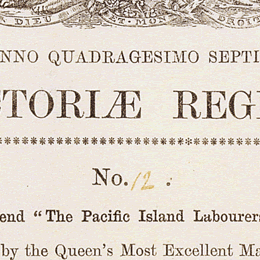
Detail of the title page of the Pacific Island Labourers Act Amendment Act 1884 (Qld).
| Long Title: | An Act to Amend 'The Pacific Island Labourers Act of 1880 (Queensland Act No. 12 of 1884) |
| No. of pages: | 4 |
| Medium: | Parchment, with black ribbon and red wax seal |
| Measurements: | 41 x 23.5 cm |
| Provenance: | This document is the original from the Queensland Title Office, now held by the Queensland State Archives. In Queensland the Governor signs three assent originals of new Acts. One is a record held by the Parliament; one by the Supreme Court; and one is a record of the Executive branch of government. Originally held in the Queensland Land Titles Office, this document is the Executive record and is now in the custody of Queensland State Archives. |
| Features: | Red seal and ribbon on p. 1, signatures on p. 2, handwritten notations on p. 4 |
| Location & Copyright: | Queensland State Archives |
| Reference: | QSA: SRS 1296/1/17 |
